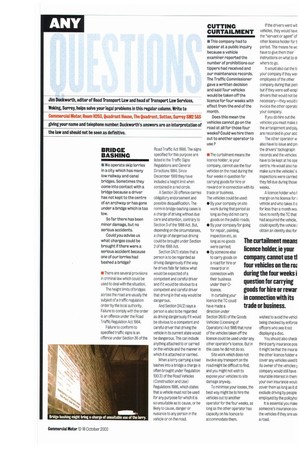BRIDGE BASHING
Page 51

If you've noticed an error in this article please click here to report it so we can fix it.
• We operate skip lorries in a city which has many low railway and canal bridges. Sometimes they come into contact with a bridge because a driver has not kept to the centre of an archway or has gone under a bridge which is too low.
So far there has been minor damage, but no serious accidents.
Could you advise us what charges could be brought if there were a serious accident because one of our lorries had bashed a bridge?
• There are several provisions in criminal law which could be used to deal with the situation.
The height limits of bridges across the road are usually the subject of a traffic regulation order by the local authority. Failure to comply with the order is an offence under the Road Traffic Regulation Act 1984.
Failure to conform to specified traffic signs is an offence under Section 36 of the
Road Traffic Act 1988. The signs specified for this purpose are listed in the Traffic Signs Regulations and General Directions 1994. Since December 1989 they have included a height limit when contained in a red circle.
A Section 36 offence carries obligatory endorsement and possible disqualification. The norm in bridge-bashing cases is a charge of driving without due care and attention, contrary to Section 3 of the 1988 Act. But, depending on the circumstances, a charge of dangerous driving could be brought under Section 2 of the 1988 Act.
Section 2A(1) states that a person is to be regarded as driving dangerously if the way he drives falls far below what would be expected of a competent and careful driver and if it would be obvious to a competent and careful driver that driving in that way would be dangerous.
And Section 2A(2) says a person is also to be regarded as driving dangerously if it would be obvious to a competent and careful driver that driving the vehicle in its current state would be dangerous. This can include anything attached to or carried on the vehicle and the manner in which it is attached or carried.
When a lorry carrying a load bashes into a bridge a charge is often brought under Regulation 100(3) of the Road Vehicles (Construction and Use) Regulations 1986, which states that a vehicle must not be used for any purpose for which it is so unsuitable as to cause, or be likely to cause, danger or nuisance to any person in the vehicle or on the road.












































































































